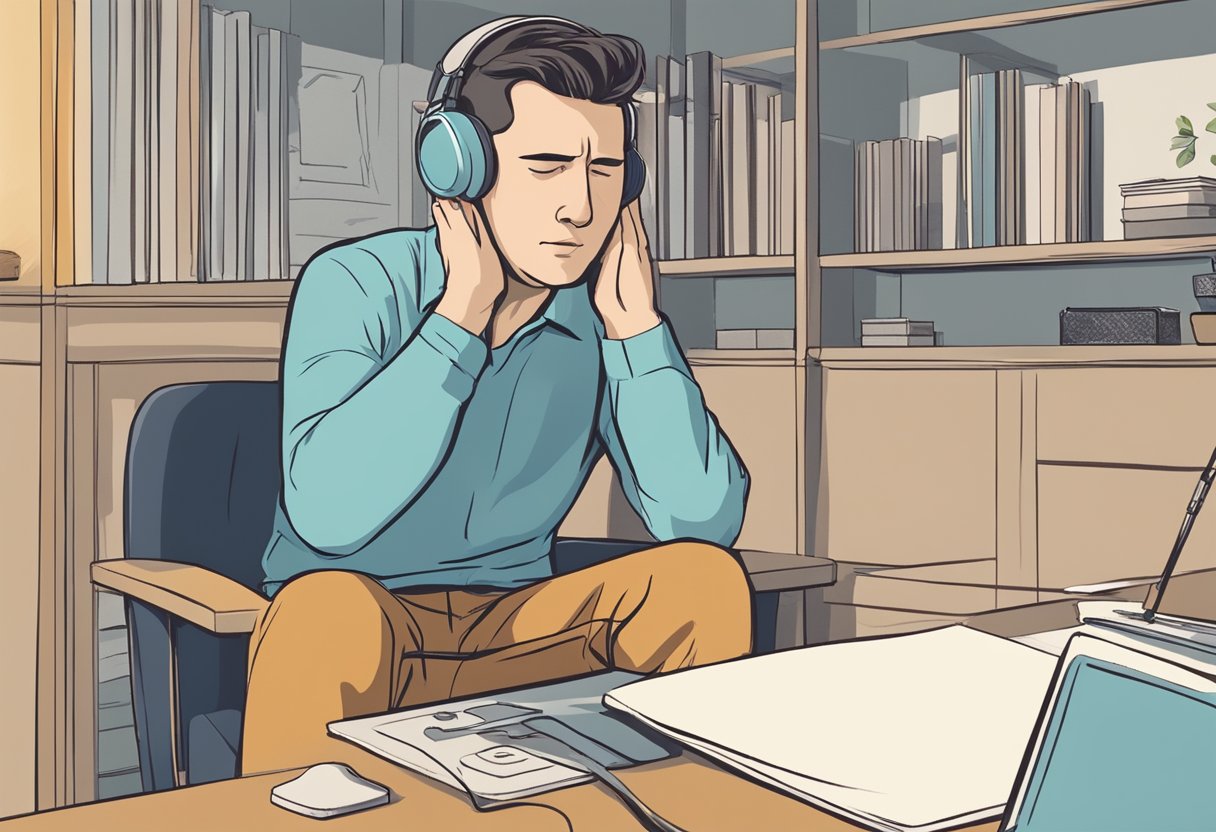Explore our expert guide on hypersensitivity to sound, providing insights and strategies to manage auditory sensitivity effectively.
Table of Contents
Introduction – Hypersensitivity to Sound
Hypersensitivity to sound, or hyperacusis, is a condition characterized by an abnormal intolerance to everyday sound levels that most people can tolerate comfortably. Those affected may experience discomfort or pain from sounds that do not seem loud to others. Factors contributing to this condition can vary widely, including hearing loss, which can make normal sounds seem overwhelming, or exposure to loud noises over time, leading to a sensitization of the auditory system.

One common misconception about hypersensitivity to sound is that it only affects people with hearing loss. However, it can also impact individuals with normal hearing and may coexist with other conditions, such as tinnitus, Meniere’s disease, post-traumatic stress disorder (PTSD), depression, or autism. Recognizing and accurately diagnosing hyperacusis is the first step toward managing the condition. Treatment may include sound therapy, counseling, or ear protection to help increase tolerance to sound.
Key Takeaways
- Hyperacusis is an increased sensitivity to normal sound levels and can cause significant discomfort.
- Misconceptions exist around hyperacusis, as it can affect individuals with both normal and impaired hearing.
- Proper diagnosis and treatment are essential for improving sound tolerance and quality of life.
Understanding Hypersensitivity to Sound

Hyperacusis is an often misunderstood hearing disorder characterized by an increased sensitivity to certain frequencies and volume ranges of sound. Individuals with hyperacusis may find everyday noises painfully loud, significantly affecting their quality of life.
What Is Hyperacusis?
Hyperacusis is a condition where a person experiences an abnormal intolerance to everyday sounds that would not be bothersome for others. This sensitivity to sound can manifest differently among affected individuals. Sounds considered normal can be perceived as intolerably loud, leading to pain and discomfort. The disorder is distinct from phonophobia, where the fear is linked to specific sounds, and from misophonia, which is a strong negative reaction to specific sounds.
Common Symptoms and Diagnosis
The primary symptom of hyperacusis is a heightened and often painful response to sounds that others perceive at normal loudness levels. This sensitivity to noise can lead to secondary symptoms, including anxiety, social withdrawal, and possible hearing loss. Diagnosis typically involves a hearing test by an audiologist, and the condition is diagnosed based on the patient’s subjective experience of sound loudness and a noticeable impact on daily life.
Causes and Risk Factors
Causes of hyperacusis can include damage to the cochlea from exposure to loud noises or head trauma. Other factors may include ear damage from toxins or medications or associated conditions such as Ménière’s disease or post-traumatic stress disorder (PTSD). Certain risk factors, including a history of ear infections or surgery to the jaw or face can also exacerbate sensitivity to sounds.
| Key Findings | Relevant Keywords and Entities |
|---|---|
| Hyperacusis is a heightened sensitivity to normal sound volumes. | Hearing disorder, pain, sensitivity to sound |
| Sounds can be perceived as unbearably loud. | Sensitivity to noise, loudness |
| Diagnosis involves subjective reporting of sound tolerance. | Hearing loss, sensitivity to sounds |
| Associated with various causes, including ear damage and related health conditions. | Causes of hyperacusis |
For further reading on the condition, please visit:
- Understanding hyperacusis for insight into sound sensitivity.
- Cleveland Clinic’s overview on hyperacusis and sound tolerance.
- Insights into reduced sound tolerance.
Associated Conditions

Hyperacusis is often correlated with various medical and psychological conditions that can exacerbate or contribute to the severity of the sound sensitivity. This section explores the intricate relationships between hyperacusis and these associated conditions.
Psychological Impact
Anxiety and depression are common among individuals with hyperacusis, as the persistent discomfort can lead to heightened stress and social withdrawal. Those with this sound sensitivity may also experience a popping sensation in the ear or exhibit signs of Posttraumatic stress disorder (PTSD), adding to their distress.
Related Hearing Disorders
Hyperacusis can coexist with tinnitus, a condition marked by hearing phantom sounds. Additionally, disorders such as Meniere’s disease, which affects balance and hearing, can also manifest alongside hyperacusis, affecting one’s overall auditory experience.
Systemic Health Connections
Several systemic health issues show connections with hyperacusis. Conditions present at birth, such as autism spectrum disorder and Williams syndrome, often include hyperacusis as a symptom. A history of head injury, migraine, or Bell’s palsy may also be linked to the development of sound sensitivity. Furthermore, infectious diseases like Lyme disease can occasionally result in hyperacusis.
| Condition | Keyword | Citation URL |
|---|---|---|
| PTSD | Stress | WebMD |
| Meniere’s Disease | Loud Noise | Cleveland Clinic |
| Tinnitus | Phantom Sound | Verywell Health |
| Autism | Birth Conditions | Healthline |
| Bell’s Palsy | Head Injury | Medical News Today |
Key Findings:
- Anxiety and depression are prevalent in patients with hyperacusis, contributing to a diminished quality of life.
- Meniere’s disease and tinnitus frequently occur alongside hyperacusis, complicating the auditory condition.
- Links between hyperacusis and conditions such as PTSD, autism, and Williams syndrome underscore the diverse nature of this sensitivity.
Treatment Strategies

Effective management of hypersensitivity to sound, or hyperacusis, includes a variety of strategies. These strategies range from medical interventions to therapeutic approaches and lifestyle adaptations that collectively aim to reduce symptoms and improve the quality of life.
Medical Interventions
Medical treatment can include the prescription of medication to manage associated symptoms like anxiety or migraines that may exacerbate hyperacusis. In some cases, doctors may recommend more invasive procedures, such as surgery, if hyperacusis is a result of underlying physical anomalies.
Therapies and Rehabilitation
Cognitive Behavioral Therapy (CBT) and Tinnitus Retraining Therapy (TRT) are prominent forms of therapy aimed at modifying the patient’s emotional response to sound and teaching them to redirect their attention away from the tinnitus sound. Meanwhile, sound therapy uses controlled exposure to noise to desensitize the ear to everyday sounds. Evidence suggests that combining sound therapy with other treatment modalities may be effective (Cleveland Clinic Health).
Lifestyle Adjustments and Home Remedies
Simple lifestyle adjustments, such as using white noise devices to mask troubling sounds, can provide immediate relief from hypersensitivity. Individuals may also practice relaxation techniques and acupuncture as home remedies to alleviate stress and improve their tolerance to sound. Avoiding exposure to loud noises and using ear protection can prevent symptoms from worsening.
| Treatment Type | Key Findings | Related Keywords |
|---|---|---|
| Medical Interventions | Medication may be prescribed for associated symptoms; surgery is less common. | medication, surgery |
| Therapies and Rehabilitation | CBT and TRT focus on emotional and psychological aspects; sound therapy involves controlled noise exposure. | CBT, TRT, sound therapy |
| Lifestyle Adjustments | White noise devices and relaxation techniques are beneficial; protection from loud noises is essential. | white noise, relaxation |
Sources for the section include the following URLs:
| Source |
|---|
| Cleveland Clinic Health – 5 Ways to Cope with Sensitivity to Sound |
Managing Hyperacusis in Daily Life

Effective management of hyperacusis entails adopting strategies for living with sound sensitivity, fostering healthy social interactions and relationships, and navigating work and school environments with greater ease.
Living with Sound Sensitivity
Those living with hyperacusis typically find everyday noises painfully loud. The use of sound therapy, which involves controlled exposure to sound, can make these sounds more manageable. Additionally, wearing ear protection in noisy environments can protect the ears from further discomfort.
| Key Approach | Description |
|---|---|
| Sound Therapy | Gradual exposure to sound to reduce sensitivity |
| Ear Protection | Use of earplugs or earmuffs to minimize noise impact |
References for Living with Sound Sensitivity:
Social Interactions and Relationships
Hyperacusis can lead to social isolation due to a person’s struggle to engage in typically noisy social settings. Individuals must communicate their needs to friends and family, including seeking quieter venues for gatherings. Consultation with a specialist might also provide strategies to handle relationship issues that arise from sound sensitivity challenges.
| Key Strategy | Description |
|---|---|
| Communication | Discussing sound sensitivity with loved ones |
| Specialist Consultation | Seeking advice on managing social and relationship aspects |
Links for Social Interactions and Relationships:
Navigating Work and School Environments
Hyperacusis can significantly affect a person’s ability to function in work and school settings, where control over the sound environment is limited. Requesting accommodations such as a quiet workspace or permission to use sound-cancelling headphones may be necessary. It is also crucial to foster an understanding of hyperacusis among colleagues and peers to create a more suitable acoustic environment.
| Solution | Description |
|---|---|
| Workspace Accommodations | Adjustments to the work or school setting for noise reduction |
| Educational Advocacy | Informing others about hyperacusis to foster support and understanding |
Educational Sources for Work and School Accommodations:
Advancements in Hyperacusis Research and Support

In the arena of medical science, particularly concerning hypersensitivity to sound, known as hyperacusis, there have been significant strides in both research and the development of support mechanisms for individuals affected by this condition. Researchers have been exploring various tools for monitoring and managing hyperacusis symptoms, from innovative questionnaires to devices tailored for pain management.
A crucial tool in hyperacusis assessment comes from the German Questionnaire on Hypersensitivity to Sound (GÜF), which measures individuals’ distress due to hyperacusis (Clinical and investigational tools for monitoring noise-induced hyperacusis). Audiologists and other medical professionals now have better frameworks to understand the impact of hyperacusis on patients’ lives.
Moreover, hearing aids and sound therapy have been leveraged to reduce auditory gain, an underlying factor of both hyperacusis and tinnitus (Sound Therapy to Reduce Auditory Gain for Hyperacusis and Tinnitus). Clinicians are incorporating these devices as part of their comprehensive treatment plans.
Additionally, support for those suffering from hyperacusis now emphasizes preventing setbacks, which includes self-regulation strategies like avoiding loud noises and the use of earplugs (Clinical Advancements for Managing Hyperacusis with Pain).
The table below summarizes these key findings and provides the URLs to the relevant research.
| Key Findings | Source URL |
|---|---|
| GÜF as a tool for assessing hyperacusis | ncbi.nlm.nih.gov |
| Hearing aids and sound therapy for auditory gain reduction | ncbi.nlm.nih.gov |
| Support strategies for hyperacusis | journals.lww.com |
The evolution of such innovations allows for an enhanced understanding and management of hyperacusis, offering those affected a better quality of life.
Conclusion
Hyperacusis, an abnormal sensitivity to sound, significantly affects a person’s quality of life. Therapeutic approaches aim to improve sound tolerance through gradual exposure to controlled sound levels. Popular methods, such as sound therapy, have shown efficacy in heightening sound tolerance over typically up to 12 months. On the other hand, some patients may also benefit from the transient noise reduction features found in modern hearing aids for managing loud household impulse sounds.
When considering treatment, it is important to focus on individualized approaches. Each person experiences hyperacusis uniquely, and so the plan must align with their specific sound sensitivities. Alongside sound therapy, cognitive-behavioral strategies can be invaluable for managing the frequently accompanying symptoms, such as anxiety or social withdrawal, thus offering a more comprehensive treatment plan.
Technology advancements in hearing aids have contributed to the progress of managing hyperacusis, facilitating improved hearing sensitivity and sound tolerance. When addressing the condition in children, studies suggest tailoring the therapy to their unique clinical profiles to enhance outcomes effectively.
The management of hyperacusis involves multi-faceted approaches, demanding both time and patience. Nevertheless, pursuing technological and therapeutic advancements continues to offer hope for those affected.
| Key Findings | Relevance |
|---|---|
| Sound therapy improves tolerance | Hyperacusis management |
| Individualized treatment plan | Addresses unique experiences |
| Use of hearing aids with noise reduction | Technological aid for symptoms |
| Related Keywords |
|---|
| Auditory system |
| Hearing sensitivity |
| Sound tolerance |
Frequently Asked Questions
Several questions frequently emerge when addressing hypersensitivity to sound, including its causes, diagnosis, psychological connections, treatment options, and symptomatology.
What causes sudden noise sensitivity in individuals?
Sudden noise sensitivity, or hyperacusis, can be incited by various factors, including ear damage from exposure to loud noises, ear infections, or head injuries. Conditions such as Meniere’s disease can also contribute to such sensitivity.
How is auditory hypersensitivity diagnosed in adults?
Auditory hypersensitivity in adults is typically diagnosed through a clinical evaluation by hearing specialists. Tests may include detailed hearing exams, such as audiograms or sound tolerance levels, to determine the degree of sensitivity.
Can anxiety contribute to sensitivity to sound?
Yes, anxiety can exacerbate or contribute to sensitivity to sound. Individuals with anxiety may have a heightened awareness or fear of sound, leading to experiences of discomfort or distress from everyday noises.
What are common treatments available for hyperacusis?
Common treatments for hyperacusis focus on lowering the excessive response to sound. This may include sound therapy, hearing protection devices, or behavioral counseling. In some cases, addressing any underlying conditions, such as TMJ disorders, is necessary.
Are there particular symptoms that characterize hyperacusis?
Hyperacusis is characterized by heightened sensitivity to normal environmental sounds. Symptoms can range from mild discomfort to severe pain and can impact one’s ability to partake in daily activities due to the overwhelming nature of certain sounds.
What is the relationship between psychiatric disorders and noise sensitivity?
There is a noted relationship between psychiatric disorders, such as depression and PTSD, and noise sensitivity. Individuals with these conditions often report a lower tolerance to sound, which can manifest as hyperacusis or phonophobia, with the latter being a fear of sound that may cause pain.
| Key Finding | Source URL |
|---|---|
| Meniere’s disease can be a factor in sudden noise sensitivity. | https://www.webmd.com/brain/sound-sensitivity-hyperacusis |
| Audiograms are used in the diagnosis of auditory hypersensitivity. | https://my.clevelandclinic.org/health/diseases/24320-hyperacusis |
| Anxiety heightens awareness and fear of sound. | |
| Sound therapy and hearing protection devices are used in treatment. | https://northwestaudiology.com/understanding-hyperacusis/ |
| Symptoms include heightened sensitivity and sometimes pain. | |
| Depression and PTSD are linked to noise sensitivity. |
